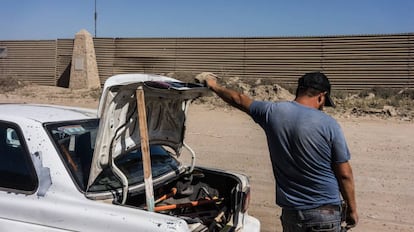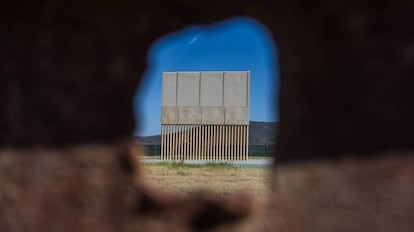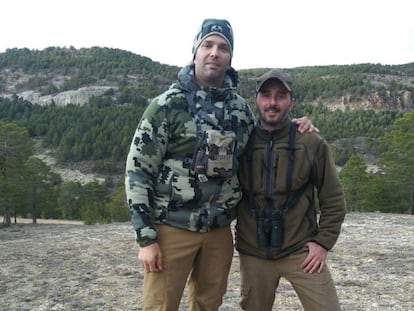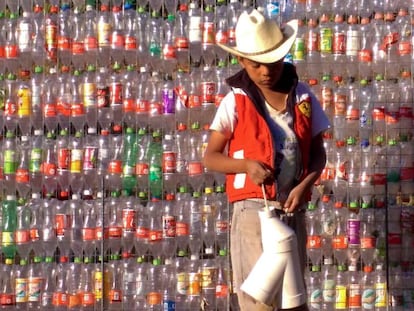“I am a neighbor of the wall of shame”
Near the spot where eight border wall prototypes stand, Mexican residents feel anger and indifference

“The wall? It’s a solemn stupidity, a joke that makes me angry as a Mexican,” says Tony Valdez, standing just a few steps from the fence that already exists between San Diego and Tijuana. A few meters into US territory, there is another wall made of concrete. And in between both, eight border wall prototypes representing Donald Trump’s obsession ever since he announced he was running for president in June 2015.
“I am a neighbor of the wall of shame,” says Valdez. The construction of the new Trump border wall is already a reality: it began a week ago in the area between Chihuahua and New Mexico, and will soon reach California according to plans.
They can put up a thousand walls, but Mexicans will still get through
Tony Valdez, local resident
The “line” has marked the life of 33-year-old Valdez, who arrived in Tijuana at the age of seven and moved to the neighborhood of Las Torres, very near the border. The migra (border patrol) has always been a presence here. A week ago, his brother crossed into Oregon after paying a smuggler $7,000. The border has its own laws, Valdez explains. No money, no crossing. Undocumented migrants are such a profitable business that traffickers now accept payment in instalments. That is how Valdez’s brother paid for his journey.
“They can put up a thousand walls, but Mexicans will still get through, they will keep trying to make a living for themselves,” says Valdez before complaining about the thousands of US patrol agents that have been deployed along the border.
María Magdalena Palacios, 56, shares this view. Her house sits across from one of Trump’s prototypes. “I’ve had my papers ever since the immigration amnesty, my husband was a gringo,” says Palacios, who still remembers Trump’s visit to this area a month ago.

“When El Trumpas showed up, they shut down all the streets on the Mexican side, nobody could get in or out,” recalls Jorge Pérez, 47, who works at an impound lot. In late March, the US Congress released $1.6 billion in funds to build the wall – far from the $25 billion that the president had initially requested.
The traces of his visit are still visible. There are piles of trash that was picked up on the side streets and left near the wall. There are vehicle tires and mounds of assorted rubbish that double as elevated viewing platforms for those who want to peek into the US side.
A lot of reporters have been down here, and there are even organized tours that start at the San Diego Museum of Contemporary Art, with the aim of raising awareness on both sides of the wall.
But not all local residents of Las Torres, Rancho Escondido and Nido del Águila – fringe areas of Tijuana – are comfortable with all the recent attention. “They raise hell, they let our dogs loose, they ask a lot of questions,” complains 18-year-old Kevin Ávila.
Ávila’s family owns a junkyard, and while he is working on a car engine, another car’s radio is blasting out a corrida song in honor of El Cochiloco, a drug lord who died in the 1990s and was said to be a close associate in Mexico of Colombia’s Pablo Escobar. A group of young thugs notice the out-of-towners and take pictures with their cellphones from inside a black van, then go on their way.
“All borders have their powers: there’s the polleros (people smugglers), the narcs, the federal police, and everyone has their territory,” notes Valdez. “This is rough country, you need to watch your back.”
A few meters up ahead, constant clouds of dust signal the passage of trucks that line up to cross the border; inside the cabins, the drivers look asleep, slumped behind the wheel as they face a wait that could stretch for hours.
The border wall prototypes were erected a couple of kilometers from the Otay Mesa port of entry. A new access door is slated to be built very near Nido del Águila to relieve the pressure on the two existing access points on the busiest border in the world.
On one side, there’s the desert. On the other, a sea of homes. On one side, a bricklayer earns $140 a day; on the other, his brother tries to make ends meet with a small business. One side has the freeways, the other the dirt roads. On one side they are illegal, on the other they are free.
“There’s no need to go jumping over, I’m happy right here,” says Valdez before returning to work.
English version by Susana Urra.
Tu suscripción se está usando en otro dispositivo
¿Quieres añadir otro usuario a tu suscripción?
Si continúas leyendo en este dispositivo, no se podrá leer en el otro.
FlechaTu suscripción se está usando en otro dispositivo y solo puedes acceder a EL PAÍS desde un dispositivo a la vez.
Si quieres compartir tu cuenta, cambia tu suscripción a la modalidad Premium, así podrás añadir otro usuario. Cada uno accederá con su propia cuenta de email, lo que os permitirá personalizar vuestra experiencia en EL PAÍS.
¿Tienes una suscripción de empresa? Accede aquí para contratar más cuentas.
En el caso de no saber quién está usando tu cuenta, te recomendamos cambiar tu contraseña aquí.
Si decides continuar compartiendo tu cuenta, este mensaje se mostrará en tu dispositivo y en el de la otra persona que está usando tu cuenta de forma indefinida, afectando a tu experiencia de lectura. Puedes consultar aquí los términos y condiciones de la suscripción digital.
More information

US president’s eldest son enjoys hunting trip in Spain
Archived In
Últimas noticias
The new victims of the Republican war on Obamacare: Millions hit by soaring health insurance premiums
A country divided on migrant rights: Some US states expand protections while others restrict them
Venezuela authorizes the release of another 87 political prisoners
There is as much life left to discover on planet Earth as that which is already known
Most viewed
- David King, chemist: ‘There are scientists studying how to cool the planet; nobody should stop these experiments from happening’
- Reinhard Genzel, Nobel laureate in physics: ‘One-minute videos will never give you the truth’
- Oona Chaplin: ‘I told James Cameron that I was living in a treehouse and starting a permaculture project with a friend’
- Sinaloa Cartel war is taking its toll on Los Chapitos
- The Interoceanic Train, the Mexican alternative to the Panama Canal










































